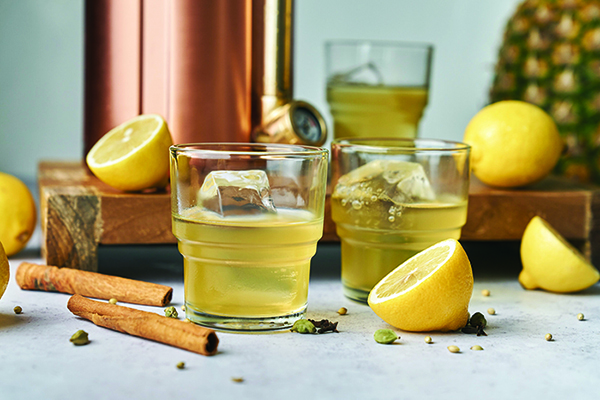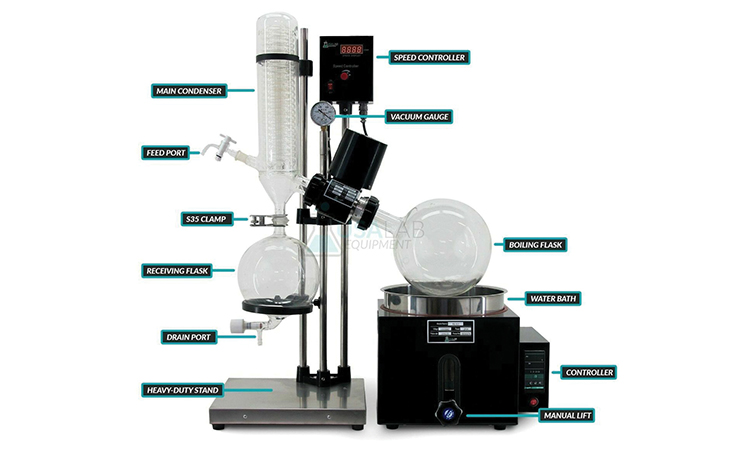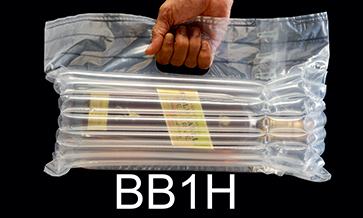Luxury cocktail bars around the world – and even some spirits brands – employ a sophisticated piece of equipment called a rotary evaporator (rotovap) to create flavour-focused cocktail components through vacuum distillation.
The equipment made it out of a science laboratory to be employed in high-end restaurant kitchens, and now bartenders are building on the tool’s culinary applications to distill drink ingredients.
Chances are you haven’t encountered rotovap-produced ingredients yet. They’re not common; aside from the rotovap being a complex piece of culinary and distillation technology to use, one cannot see it around too often because of its price. Most such equipment costs upwards of US$ 15,000 (Rs 12 lakh) for the full setup!
Commercial instruments include the basic features, and various traps are manufactured to insert between the evaporation flask and the vapour duct. Modern equipment adds features such as digital control of vacuum, digital display of temperature and rotational speed, and vapour temperature sensing.
Rotovap cooking is more popular, in comparison, in molecular gastronomy for the preparation of distillates and extracts. For example, an American chef adds distilled extract from forest soil to gel and match with oyster into his signature dish.
Rotovap cooking used for separating and concentrating food molecules is the most popular cooking method among high-end restaurants. It also applies to concentrate the purest and freshest flavours from a blood orange by removing the water, extract the desired flavours from a blend of alcohol, herbs and fruit, without heating the mixture.
How it works
Increasingly, more bars are choosing to invest in a rotovap to produce better and more interesting cocktails. Traditional distillation purifies a liquid by heating it up to evaporate and cooling it down with a condenser to reclaim the distilled vapours.
A rotovap, on the other hand, lowers the pressure of the ingredient’s environment using vacuum, which lowers the boiling point significantly. In standard distillation, one tries to concentrate alcohol and reduce unwanted contaminants. In rotary evaporation, one tries to capture all the volatiles from the flavour one is looking to distill.
This leads to the final product being clean and fresh, unaffected by the flavour-killing heat. It is particularly beneficial when working with ingredients such as fruits and herbs.
Simply put, it evaporates the solvent, separating the liquid from the solids, and even removes the colour, spice and bitterness of ingredients as well. Chefs typically use a rotovap to harvest the solid portions of ingredients; but bartenders are more interested in extracting the evaporated solvent.
Use in cocktails
The rotovap has a large number of applications in cocktails, but essentially it’s used either to add flavour by capturing and preserving the aroma of spices and fresh herbs. These would otherwise be lost if you dried them out or applied heat to them.
A London bar uses the rotovap to flavour its ready-to-drink Sandalwood Martini with a distillate of sandalwood, which brings a very distinctive, soft, warm, precious wood scent to this classic.
The bar team in another London restaurant uses the rotovap to create bitters and tinctures incorporating various herbs and spices, which they present to guests as options for its renowned tableside Martinis.
Another team created a cocktail for the bar’s “minimalist” menu – in which each drink contains only two ingredients and which relies heavily on the rotovap – made with cognac and green coffee.
The drink is served over a perfectly clear ice cube as a crystal-clear liquid, the colour and tannins removed from its ingredients, but its flavour distinctly that of coffee and Cognac.
A micro-distillery in Copenhagen (Denmark) uses large-scale, low-temperature distillation to extract the essence of rare ingredients such as Mexican chile and pasilla mixe. The resultant drink tastes of smoke, earth and dark red fruits, but leaves out the spice.
A micro-distilled spirits brand in the US uses a rotovap to flavour its gins. It also creates single-note vodkas and re-distills spirits for cocktails with unexpected flavours. The rotovap is equally good for splicing textures and extracting unexpected flavours from minerals, barks and exotic spices.

Chefs typically use a rotovap to harvest the solid portions of ingredients; but bartenders are more interested in extracting the evaporated solvent.
Note of caution
Cost apart, there are many things to consider before (and after) commissioning one for your bar. First off, distillation at home or a bar is illegal without the requisite license.
Even if a bar is using alcohol that it purchased and paid taxes on, using a rotovap to manipulate other drinks ingredients falls into a grey area so far as legality is concerned.
Second, most rotovaps come with small flasks and condensers as standard equipment. For bar operations, one might need bigger capacities – which could mean customisation at an extra cost.
Most such flasks come in glass, a potential operational hazard (not to mention bad publicity) in case of an accident. Heat-resistant or plastic-coated glass comes at an additional premium.
The rotating parts of a rotovap make it imperative to keep loose clothing, hair and jewellery out of harm’s way. The chances for breakage, burns and chemical exposure require extra caution, especially when working under vacuum. Even a leak can draw air into the apparatus to create a violent reaction.
All things considered, a rotovap is seen as a worthwhile investment for bar owners who want to build a unique, high-end drinks programme. For obvious reasons, it is not a piece of equipment to buy just to show it off!














